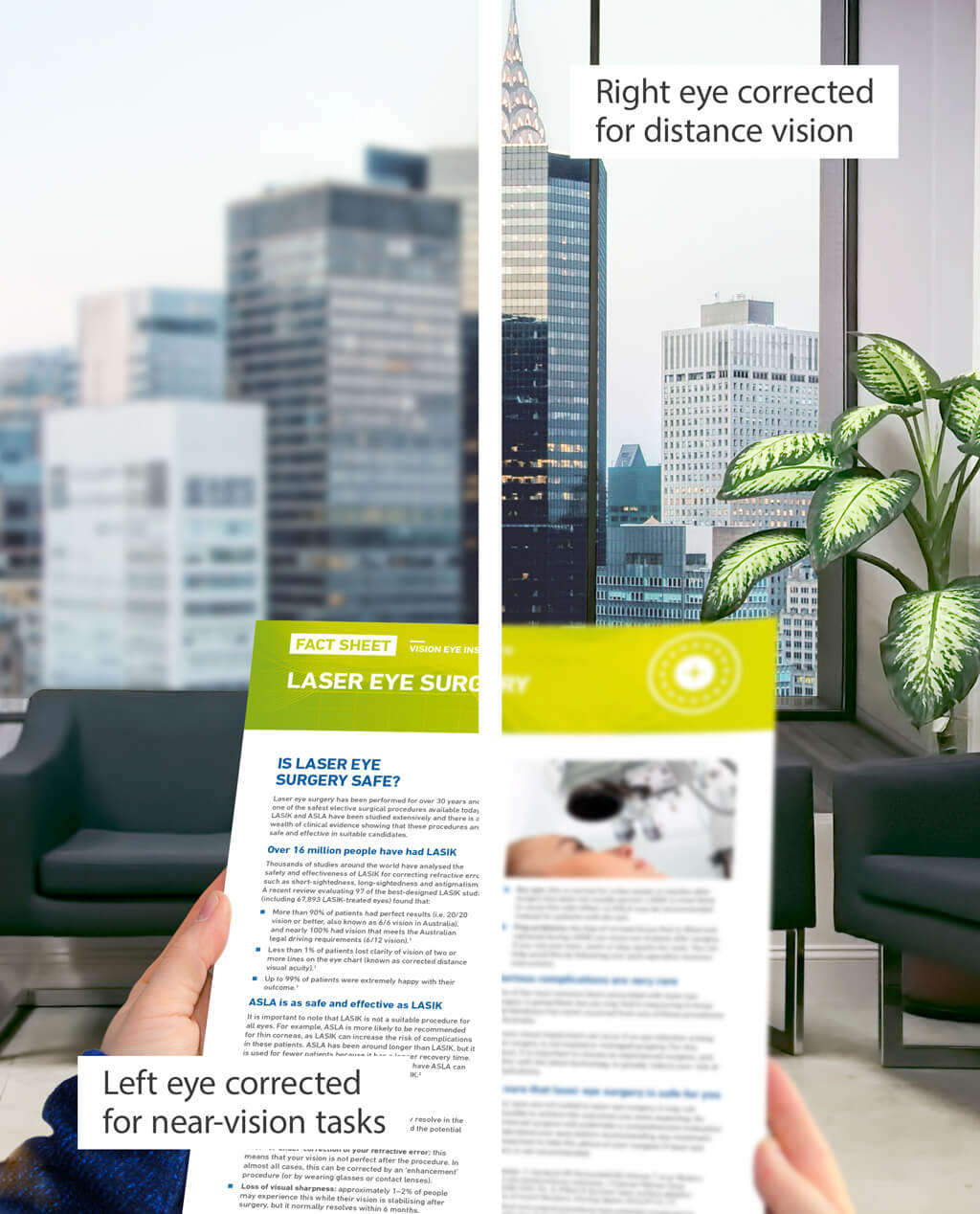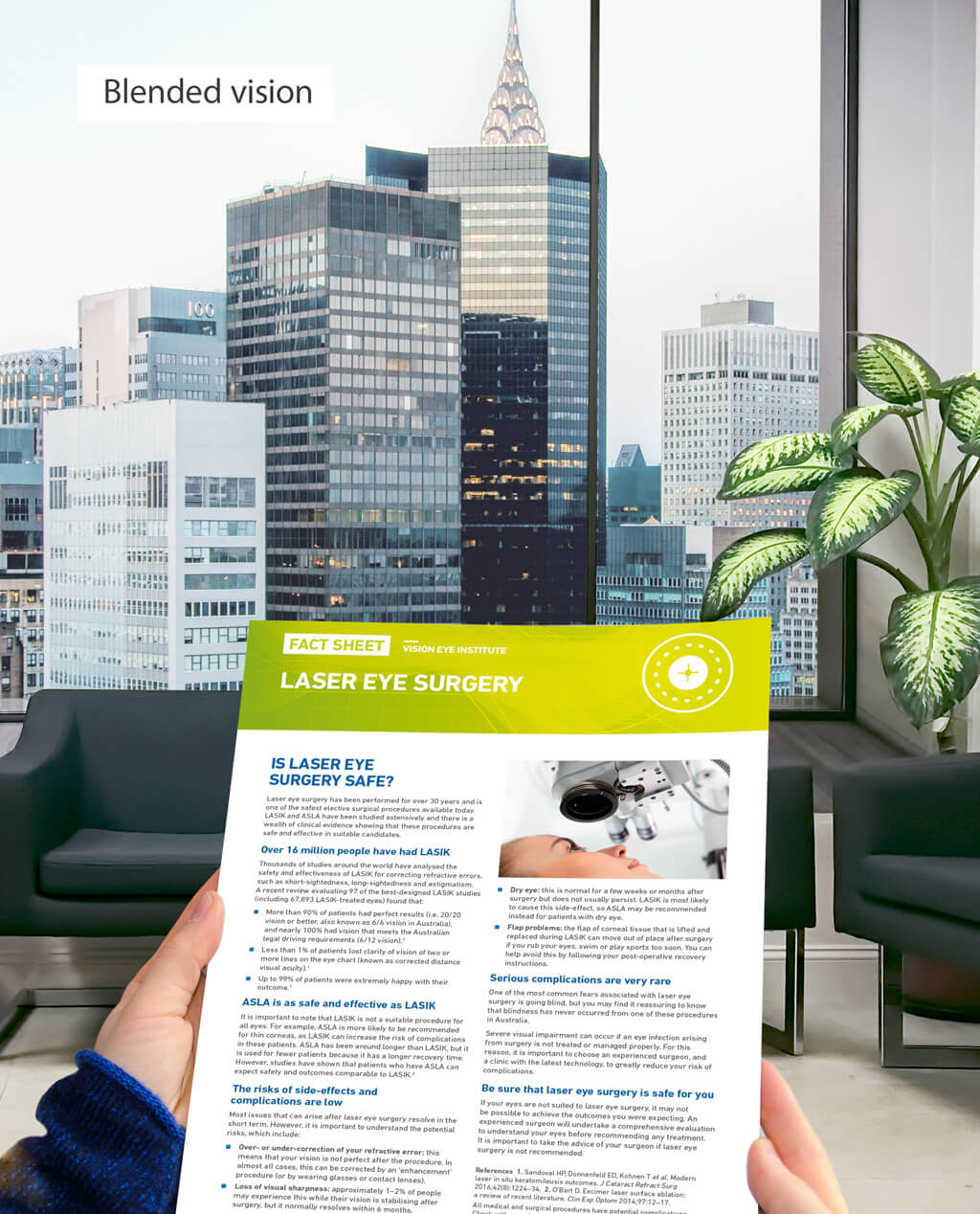"*" indicates required fields

Monovision (blended vision)
06/03/2020
Monovision, also known as blended vision, is a treatment option for people with presbyopia. Presbyopia typically begins in your mid-forties, when the eye starts to lose some of its natural ability to focus on close objects.
Monovision works by using laser or lens surgery to correct one eye for near-vision tasks (e.g. reading) and the other eye for distance vision. Your brain then ‘blends’ the images from both eyes together to produce a clear image. Reading glasses are generally not required after treatment, except when focusing on small intricate details or reading in dim light.
Who is monovision suitable for?
The best candidates for monovision treatment are those over the age of 45.
Monovision represents a major change in the way your brain processes visual information and requires a period of adaptation. Contact lenses can be used to demonstrate the visual effects of monovision in patients who are considering this treatment. Similarly, a pair of trial glasses or the phoropter (machine with individual lenses) can also be used for the same purpose. Regardless of which technique is used, a monovision trial allows your surgeon to assess your ability to adapt to the treatment.
Many patients with presbyopia can benefit from monovision, but people with the following conditions may not be suitable:
- thin or abnormally shaped corneas
- a high degree of astigmatism or a very strong prescription for glasses or contact lenses
- glaucoma or maculopathy
- significantly dry eyes.
Work, recreation and licences
Potential side-effects of monovision treatment include changes to depth perception and night vision, which may affect activities such as:
- driving at night or driving a heavy vehicle
- sporting activities such as golf
- piloting an aircraft.
Monovision treatment also has implications for certain vehicle licences, such as aviation and heavy vehicle permits. A refractive surgeon (vision correction surgeon) can advise you on your full range of treatment options, including any expected impact on your lifestyle.
What does monovision involve?
First, you will undergo a thorough eye exam and testing of your eyes to check their overall health. The dominant (stronger) eye will also be identified because it is usually corrected for distance vision, while the other eye is adjusted for near vision.
After you have been assessed for your suitability for monovision (which may include a lens trial as described above), the surgeon will decide whether to perform the treatment with laser eye surgery (LASIK, SMILE® or ASLA) or by replacing the lenses in your eye with artificial ones. Laser eye surgery is performed in the laser suite while lens exchange surgery is performed in the day surgery.
You can expect to be in the laser suite or day surgery for around 2 to 3 hours (although the surgery time itself is only around 20 minutes).
If you have been given a sedative, you may need a friend or family member to accompany you home.
In Figure 1 below, the right eye has been corrected for distance vision and the left eye corrected for near vision. After a period of adjustment, your brain will learn to selectively choose which eye’s image to focus on – this will depend on the task.
Your brain would prioritise the image from the right eye when looking at the skyline in the distance, and the image from your left eye when trying to read the brochure. Intermediate objects, such as the chairs in the waiting room, would fall into the ‘blend zone’ in which the images from both eyes are combined for better clarity and depth perception. Overall, your vision would be clear like in Figure 2 below.


Recovery
Immediately after the surgery, your vision will be slightly blurry. Many people find that they adjust within a matter of days. However, it’s important to understand that complete adaption by the brain can take some time – usually several weeks but sometimes longer. During this adjustment period, it is normal to experience slight, intermittent blurring of your vision.
Other useful links
SMILE® is a registered trademark of Carl Zeiss Meditec.
References
- Evans BJ. Monovision: a review. Ophthalmic Physiol Opt 2007;27(5):417–39.
- Choice. A guide to laser eye surgery. NSW, 11 August 2020. Available at https://www.choice.com.au/health-and-body/optical-and-hearing/optical/articles/guide-to-laser-eye-surgery [Accessed 6 January 2021].
- Wilkinson JM, Cozine EW, Kahn AR. Refractive Eye Surgery: Helping Patients Make Informed Decisions About LASIK. Am Fam Physician 2017;95(10):637–44.
The information on this page is general in nature. All medical and surgical procedures have potential benefits and risks. Consult your ophthalmologist for specific medical advice.
Date last reviewed: 2025-02-18 | Date for next review: 2027-02-18
